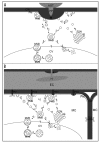Do plant cells secrete exosomes derived from multivesicular bodies?
- PMID: 19704795
- PMCID: PMC2633885
- DOI: 10.4161/psb.2.1.3596
Do plant cells secrete exosomes derived from multivesicular bodies?
Abstract
Multivesicular bodies (MVBs) are spherical endosomal organelles containing small vesicles formed by inward budding of the limiting membrane into the endosomal lumen. In mammalian red cells and cells of immune system, MVBs fuse with the plasma membrane in an exocytic manner, leading to release their contents including internal vesicles into the extracellular space. These released vesicles are termed exosomes. Transmission electron microscopy studies have shown that paramural vesicles situated between the plasma membrane and the cell wall occur in various cell wall-associated processes and are similar to exosomes both in location and in morphology. Our recent studies have revealed that MVBs and paramural vesicles proliferate when cell wall appositions are rapidly deposited beneath fungal penetration attempts or during plugging of plasmodesmata between hypersensitive cells and their intact neighboring cells. This indicates a potential secretion of exosome-like vesicles into the extracellular space by fusion of MVBs with the plasma membrane. This MVB-mediated secretion pathway was proposed on the basis of pioneer studies of MVBs and paramural vesicles in plants some forty years ago. Here, we recall the attention to the occurrence of MVB-mediated secretion of exosomes in plants.
Keywords: cell wall; endocytosis; endosome; exocytosis; exosome; multivesicular body; paramural body.
Figures


Comment on
-
Multivesicular compartments proliferate in susceptible and resistant MLA12-barley leaves in response to infection by the biotrophic powdery mildew fungus.New Phytol. 2006;172(3):563-76. doi: 10.1111/j.1469-8137.2006.01844.x. New Phytol. 2006. PMID: 17083686
-
Multivesicular bodies participate in a cell wall-associated defence response in barley leaves attacked by the pathogenic powdery mildew fungus.Cell Microbiol. 2006 Jun;8(6):1009-19. doi: 10.1111/j.1462-5822.2006.00683.x. Cell Microbiol. 2006. PMID: 16681841
References
-
- Gruenberg J, Stenmark H. The biogenesis of multivesicular endosomes. Nat Rev Mol Cell Biol. 2004;5:317–323. - PubMed
-
- Geldner N. The plant endosomal system-its structure and role in signal transduction and plant development. Planta. 2004;219:547–560. - PubMed
-
- Denzer K, Kleijmeer MJ, Heijnen HFG, Stoorvogel W, Geuze HJ. Exosome: From internal vesicle of the multivesicular body to intercellular signaling device. J Cell Sci. 2000;113:3365–3374. - PubMed
-
- An Q, Ehlers K, Kogel KH, van Bel AJE, Hückelhoven R. Multivesicular compartments proliferate in susceptible and resistant MLA12-barley leaves in response to infection by the biotrophic powdery mildew fungus. New Phytol. 2006;172:563–576. - PubMed
LinkOut - more resources
Full Text Sources
Other Literature Sources
